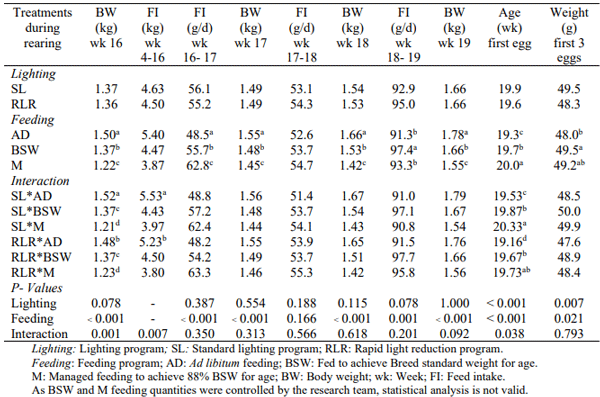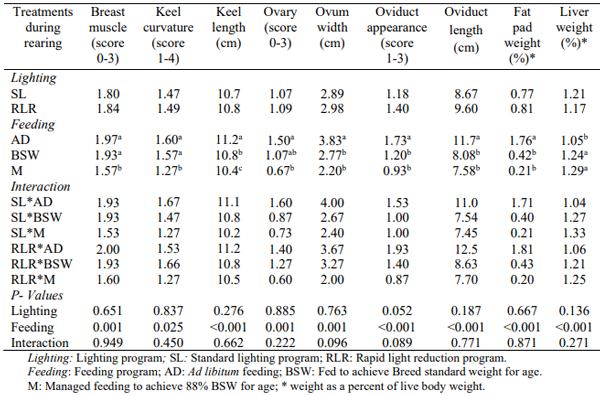I. INTRODUCTION
A hen’s physiological patterns including FI and BW trajectory are established by early lay (Muir et al. 2022). Therefore, management tools such as lighting and feeding programs during rearing may offer opportunities to regulate bird size and establish feeding habits by the end of rearing. This may also influence persistency of lay, egg quality and hen health during an extended laying period. The lighting program during rearing can modify bird age at sexual maturity, the number of eggs produced and egg size (Santiago-Anadón and Latorre-Acevedo, 2004). For example, compared to a standard lighting (SL) program, more rapid light reduction (RLR) provides fewer hours of light/day, which slows chick growth and, on light stimulation, initiates earlier sexual maturity (Arango et al., 2007). Hens reared under RLR also produced more eggs of larger size at 66 WOA. While bone mineralization did not differ (Hester et al. 2011), other features of egg quality and bird health were not reported but are worthy of evaluation.
Comparison of feeding programs during rearing undertaken during the early stages of intensification of egg production show that managing feeding can impact number of smaller eggs produced during early lay, the rate of decline in egg production from peak lay and bird mortality (Lee et al. 1971; Balnave, 1973). Such features have not been evaluated in current day Brown egg laying hens. As the industry explores extending layer hen production cycles these management options require re-evaluation in today’s layer hens. This experiment compared Hy-Line Brown pullets that had been reared under two lighting and three feeding programs at point of lay.
II. MATERIALS AND METHODS
Nine hundred, Hy-line Brown day-old chicks, were placed in groups of 30 in floorpens (7 m2) at the Zootechny research facility, Austral, NSW, Australia. All chicks were beak trimmed and vaccinated for Newcastle Disease, Infectious Bronchitis and Marek’s Disease Virus. Each pen had a perch, automatic nipple drinkers and manually filled feed hoppers. The shed was brooded with space heaters, and had side curtains, foggers, and dimmable lights with photoperiod control for each end of the shed. A light proof curtain traversed the centre of the shed separating the two lighting treatments, with 15 pens per side. All birds were held under intermittent lighting during the first week (4hLight(L):2hDark(D)) then 20hL:4hD in the second week. For RLR the photoperiod was reduced as 16hL:8hD, then 12hL:12hD and finally held at 9hL/day from 4-16 WOA. Under SL program 20hL:4hD was maintained through to 3 WOA then reduced gradually to reach 10hL:14hD by 7 WOA, which was maintained through to 16 WOA. The study was a 2 × 3 factorial arrangement of 2 lighting and 3 feeding programs. All birds were fed ad libitum until 4 WOA when three feeding programs of five pens per lighting treatment were introduced. The three feeding regimes were: ad libitum feeding; feeding to achieve breed standard weight (BSW); and feeding to achieve 88% breed standard weight (Managed) for age (Lee et al. 1971). . All birds receive the same commercial crumble pullet starter (0-5 WOA) and grower (5-12 WOA) (Barastoc, Australia), then a Developer mash (12- 16 WOA). From 16-17.4 WOA all pullets received a Pre-lay mash and then an Early lay mash both being fed ad libitum. All birds were weighed individually from 4-16 WOA. Based on their BW the amount of feed/pen/day for each BSW and Managed feeding pen was weighed out for the following week. At 16 WOA, 15 pullets from each treatment were euthanased to evaluate breast muscle, keel curvature, keel length, abdominal fat, liver weight and ovary development, ovum width, oviduct appearance and length.
Seventy hens/treatment group were then moved to individual pens in the high-rise layer shed and held under a common lighting program with gradual increase in photoperiod as per Hy-Line Brown program. The age of first egg and weight of the first three eggs was recorded. Experimental data were analysed using a factorial ANOVA with lighting and feeding programs as the main effects.
III. RESULTS AND DISCUSSION
At 16 WOA BW was highest in ad lib feeding under SL and lowest in Managed feeding under both SL and RLR (Table 1). Of the ad lib fed birds, SL allowed for the highest FI and RLR the lowest. Not surprisingly when all birds were on ad lib feeding in the layer shed, those that had been on Managed feeding during rearing had the highest FI between 16-17 WOA. Weekly FI varied between rearing treatment groups through to 19 WOA (Table 1). Despite this, at 19 WOA hen BW remained heaviest in ad lib feeding and lightest in birds of Managed feeding during rearing. Age of first egg was altered by both lighting and feeding (Table 1) with pullets fed ad lib under RLR being the youngest at age of first egg (19.16 WOA) and Managed feeding under SL the oldest (20.33 WOA). The lighter BW together with the later age of first egg in Managed birds concurs with the minimum BW for sexual maturity identified by Brody et al., (1984). Both SL and feeding to BSW during rearing independently generated the heaviest first three eggs.
Table 1 - Body weight, feed intake, age and weight of first eggs in Hy-Line Brown pullets reared under different lighting and feeding regimens.

At 16 WOA, breast muscle score, fat pad weight and keel curvature were highest in birds fed ad lib and lowest in birds receiving Managed feeding (Table 2). Heavier birds may be less able to control their flying and landing, colliding more often with the perch, feeder or pen mates (Wilkins et al 2011), resulting in damage to the keel, but this remains to be confirmed. Proportional to bird weight the Managed feeding birds had a higher percent liver weight. Features of the reproductive tract including ovary score, ovum width, oviduct appearance and oviduct length were highest in ad lib fed birds (Table 2), which concurs with their younger age at first egg and lighter weight of first three eggs (Table 1). Hence lower weight gain through controlled feeding delayed the development of sexual organs, postponing the onset of lay, also found by Bruggeman et al. (1999), with the production of heavier eggs at the start of lay. These observations are not dissimilar to those of Lee at al. (1971) and Balnave (1973) in earlier strains of egg laying hens.
These findings indicate that the management of FI and lighting during rearing can alter pullet BW, the onset of lay and the weight of the first eggs in current day egg laying hens. The effects of these rearing conditions on persistency of lay, egg quality and hen health through an extended laying cycle will be determined with the flock being followed through until hens are 100 WOA.
Table 2 - Organ characteristic of 16 week old Hy-line Brown pullets reared under different lighting and feeding regimens.
ACKNOWLEDGMENT: We thank Australian Eggs for funding this project.
Presented at the 34th Annual Australian Poultry Science Symposium 2023. For information on the next edition, click here. 











.jpg&w=3840&q=75)